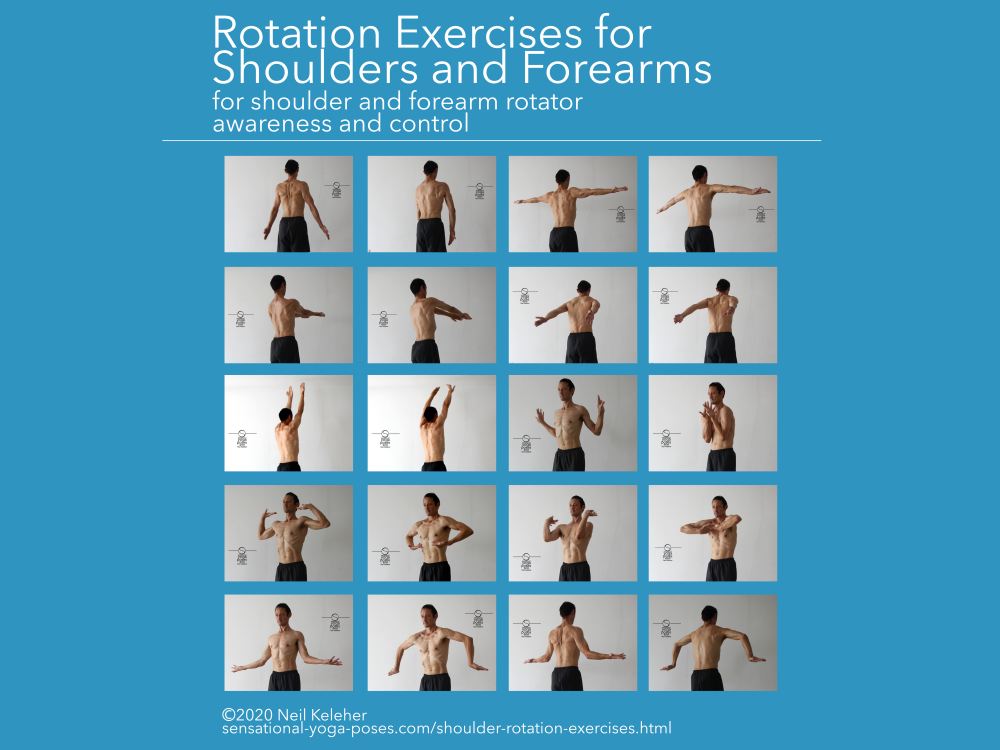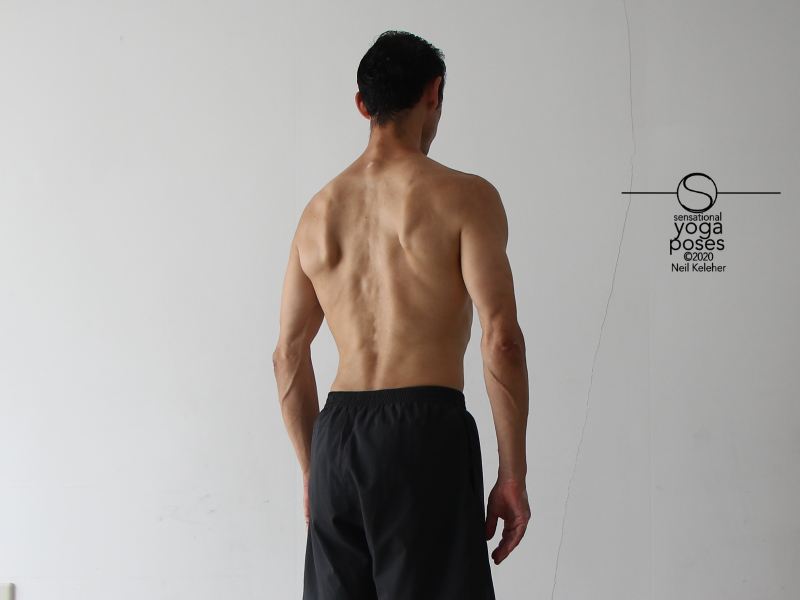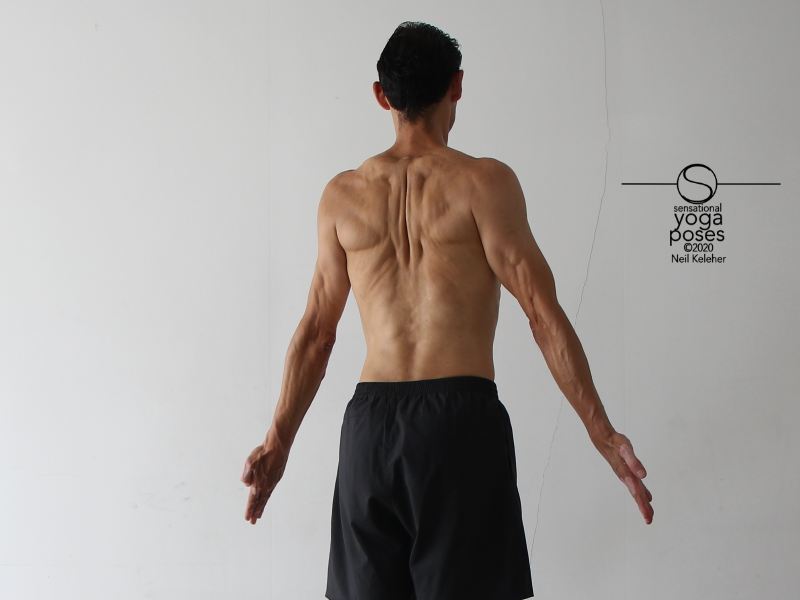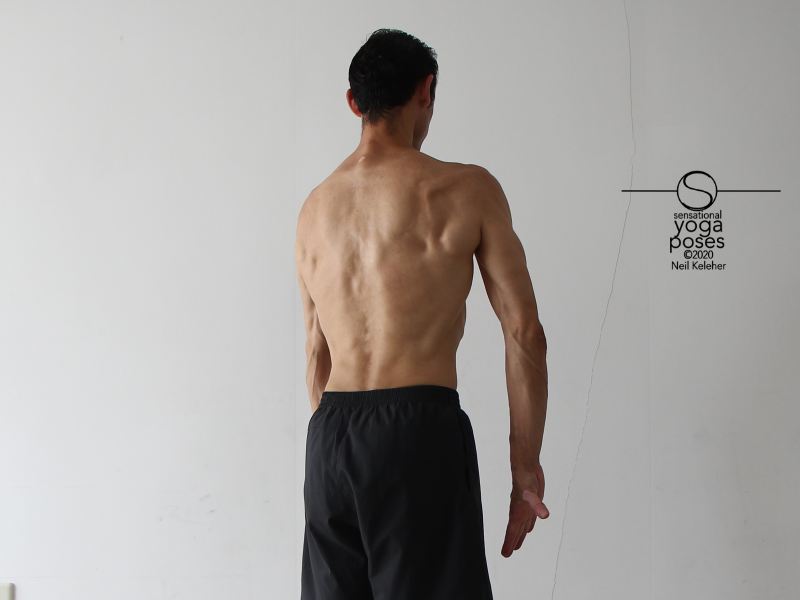Shoulder rotation exercises, toc
For external rotation of the upper you can focus on moving the front of the arms (the biceps side) outwards. For internal rotation you can focus on moving the biceps inwards.
Note that the point of the elbow follows the rotation of the upper arm and so you can also use the point of the elbow as a reference for upper arm rotation relative to the shoulder.
Note that the forearms can rotate relative to the upper arms and so it is important to be able to distinguish between upper arm rotation relative to the shoulder and forearm rotation relative to the upper arm.
To get a feel for forearm rotation, practice rotating the forearms with the elbows bent, while keeping the upper arms still. Note how the palms follow the rotation of the forearms.
Starting with the palms facing down, external forearm rotation will turn the palms upwards. From here, internal forearm rotation will turn the palms downwards. Note, rather than just turning palms upwards and downwards, see if you can rotate your forearms beyond those references.
For all of these shoulder and forearm rotation exercises, focus on moving slowly and smoothly. Feel the bones of your arms moving relative to each other and notice the muscular activation sensations that accompany (and drive) these movements.
With upper arm rotations, you may find that your shoulder blades (and collar bones) move to accomodate the movements. These are the muscles that move your shoulder blades relative to your ribcage and also work together to stabilize your shoulder blades relative to your ribcage.
Muscles that attach the from the shoulder blade (or scapula) to the ribcage include:
These muscles can also be used to stabilize the shoulder blade or fix it in place relative to the ribcage. Read more about using these muscles in scapular awareness and scapular stabilization.
Muscles that attach between the shoulder blade and the humerus include:
- subscapularis (which is located on the front surface of the shoulder blade, between it and the ribcage)
- supraspinatus (located along the top of each scapulae, above the "spine" of the scapulae.)
- infraspinatus, (located on the back of each scapulae below the spine of the scapulae),
- teres minor, (located just below infraspinatus) and
- teres major (located below teres minor.)
- coracobrachialis
- the deltoid,
The first four of these muscles constitute the rotator cuff. Their tendons attach high up on the humerus close to the "ball" of the shoulder joint.
The teres major, with its tendon inserting further down the arm bone isn't included in the rotator cuff group even though it shares a similar name. That being said, it can take part in controlling shoulder rotation.
Coracobrachialis, along with the anterior and posterior heads of the deltoid, can also be used in shoulder rotation. Depending on arm position, the medial head of the deltoid may also be involved in shoulder rotation.
The triceps long head and the biceps both attach from the shoulder blade to the bones of the forearm (the radius and ulna.)
You can read more about the shoulder muscles in shoulder anatomy and shoulder anatomy 2
With arms straight it can be harder to differentiate shoulder rotations and forearm rotations. To that end, one approach is to first rotate the upper arm, noticing the how the point of your elbow rotates with your uppe arm. From there, rotate the forearms, noticing how the direction the palm faces changes, relative to the point of the elbow.
For all of these exercises (including the bent elbow arm rotations in the following section) work at keeping your spine long. That means make your neck feel long, make the back of your ribcage, your thoracic spine, feel long, make your lumbar spine feel long all the way to the bottom tip of the sacrum.
The reason for doing this is to provide an anchor for the muscles that work between the shoulder blades and the spine and ribcage.
Additionally, you could control ribcage positioning and stability while doing these exercises.
Standing with your spine lengthening upwards, start with your arms relaxed and down by your sides. Rotate your arms outwards. Move your biceps outwards to rotate your upper arms. Notice how your shoulder blades move towards each other. (You may also notice that this makes your chest feel more open)! Rotate your forearms in the same direction but relative to the upper arms.
An optional approach is to retract your shoulder blades first (move them towards each other). Then externally rotate the upper arms and then the forearms. Then relax and then repeat.
If you have trouble "retracting" your shoulder blades, practice moving your shoulders backwards relative to your ribcage. Notice how your shoulder blades move towards each other when moving your shoulders back.
Next practice internal rotation with the arms down.
Standing with spine long, rotate your arms inwards. Start with your upper arms, moving your biceps inwards. Notice how your shoulder blades spread apart or "protract". Or notice how your upper back "feels open". Then rotate your forearms in the same direction.
When rotating
Once you are comfortable with feeling your arms and shoulder blades, again try leading with the shoulder blades. First protract, then rotate your arms inwards. Relax and repeat.
Note that if you have trouble protracting your shoulder blades, then again practice moving your shoulders forwards and backwards relative to your ribcage. Notice how your shoulders spread apart or protract when you move your shoulders forwards.
With arms out to the sides, for both internal and external rotation, you can work at keeping your shoulder blades spread apart. However, do notice, when externally rotating your arms, your shoulder blades should descend while the fronts of your shoulders lift. When internally rotating, your shoulder blades should lift while the fronts of your shoulders move down.
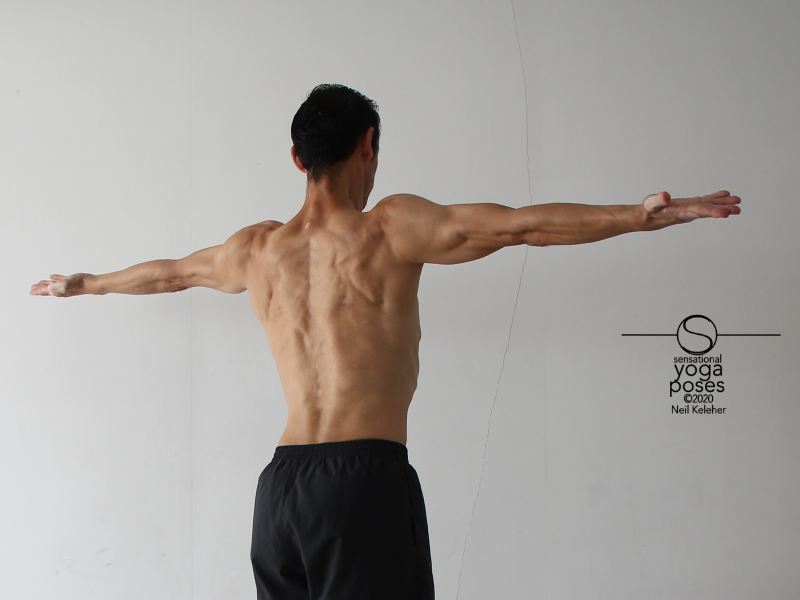
Externally Rotated
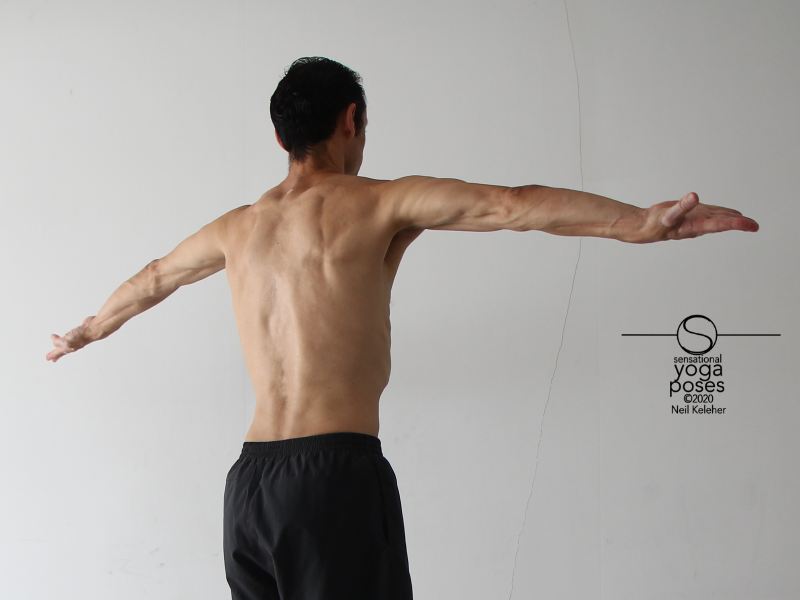
Internally Rotated
With arms reaching forwards you may find that your shoulder blades naturally protract (spread apart). You may find that it's easier to rotate your forearms first and then allow your upper arms to follow. However, for better control and awareness, once you are comfortable leading with your forearms, see if you can lead instead with your upper arms.
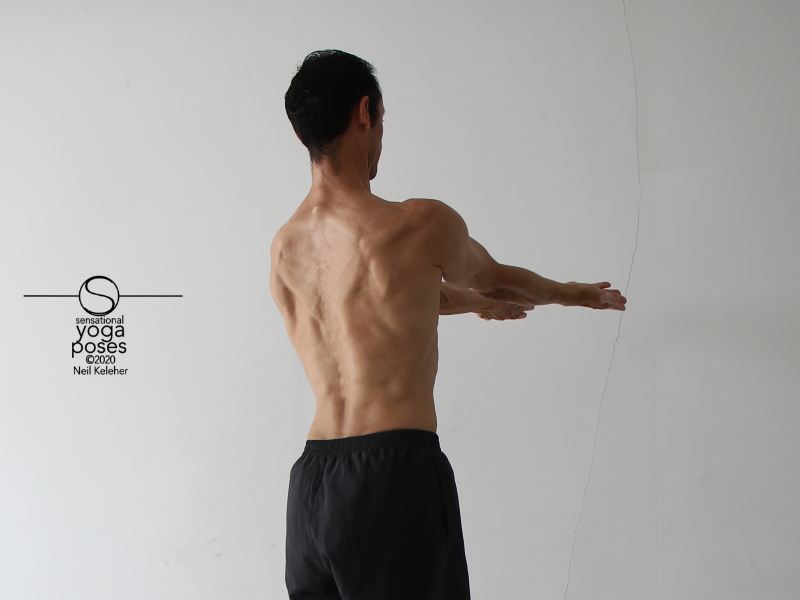
Externally rotated
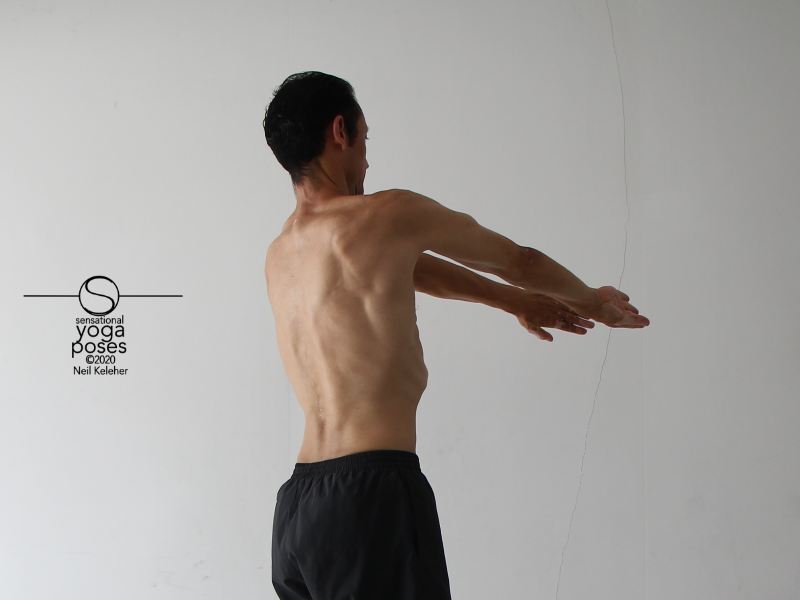
Internally rotated
In the above pictures, note the difference in angle of the inner ege of my shoulder blades.
Rotating your arms externally and internally with arms forwards, the movements of your shoulder blades may be harder to define. Try using the socket of your shoulder blade (on the outermost part of the shoulder blade) and the inner edge of your shoulder blade as references. Notice how with external rotation the shoulder socket moves slightly down and with internal rotation it moves slightly upwards.
With arms reaching back you may find that your shoulder blades naturally retract. You may also find that when reaching your arms back, it helps to drop your chest. (Do work at keeping your spine feeling long though!)
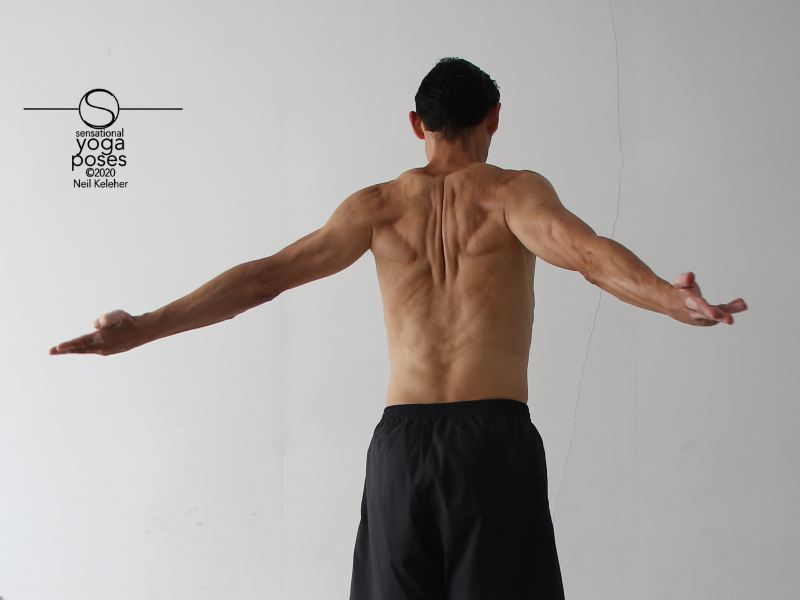
Externally rotated
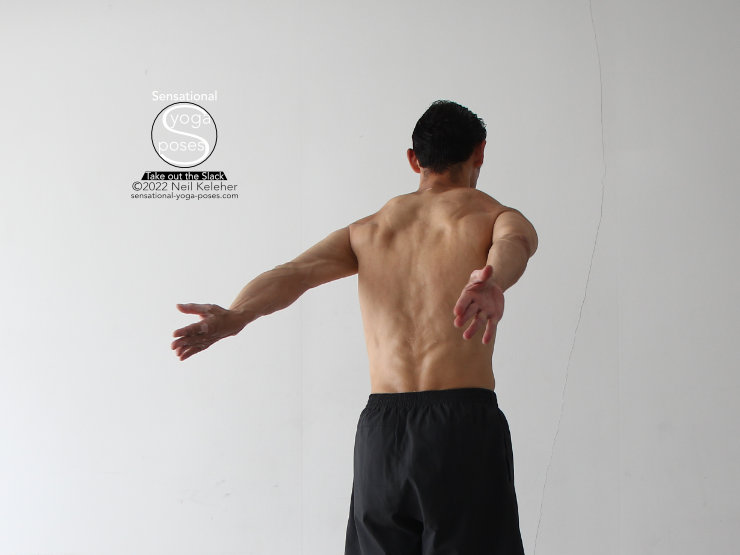
Internally rotated
With the arms back you may find it helpful to use the inner edges of your shoulder blades as references.
You may notice that with external rotation they tend to move towards each other. With internal rotation your shoulders blades spread apart slightly, particularly the top edges.
With arms up, internal rotation can be difficult and you may find that it causes shoulder pain. If that's the case, leave internal rotation out and focus on just external rotation.
With internal rotation with the arms up, you may be causing shoulder impingement. Apart from simply skipping the movement, you could experiment with lifting the shoulders higher. The higher you lift your shoulders, the more the top of the shoulders moves inwards, thus reducing the possibility of impingement.
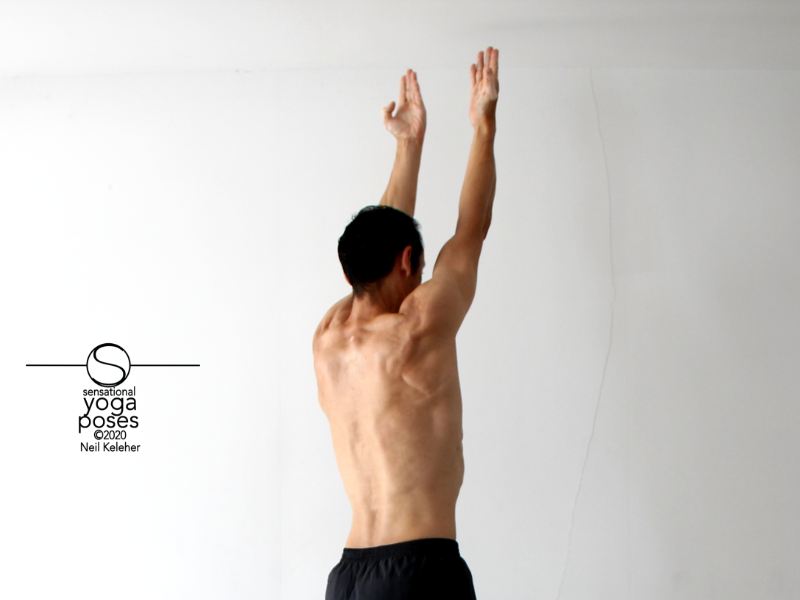
Externally rotated
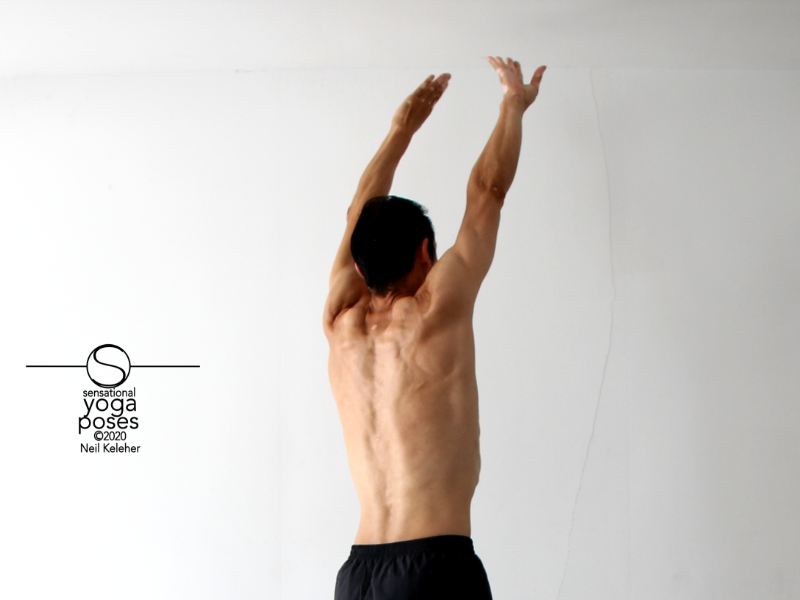
Internally rotated
With elbows bent, forearm and shoulder rotation are easier to differentiate. Even so, you can practice differentiating the two by first rotating the forearms (and noticing the accompanying sensations) and then rotating the upper arms (again noticing the accompanying sensations).
Rotating your upper arms with elbows bent upwards as show (upper arms down by your sides) can be tricky. So that you whether or not you are rotating your upper arms, for this exercise first rotate your forearms, then rotate your upper arms (while keeping the forearms rotated).
For external rotation, first rotate your forearms externally. Then rotate your upper arms. Then relax and repeat.
Once you have a feel for it, add shoulder blade retraction.
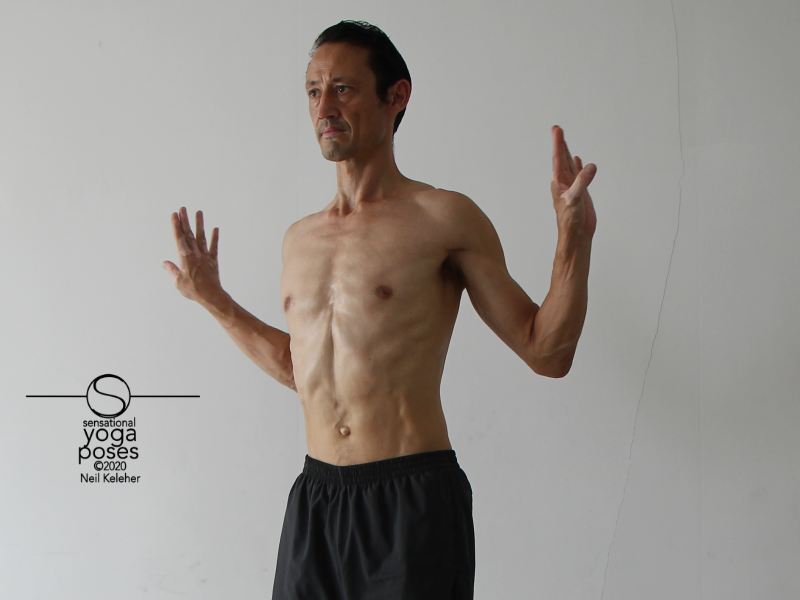
Externally Rotated with shoulder blades retracted
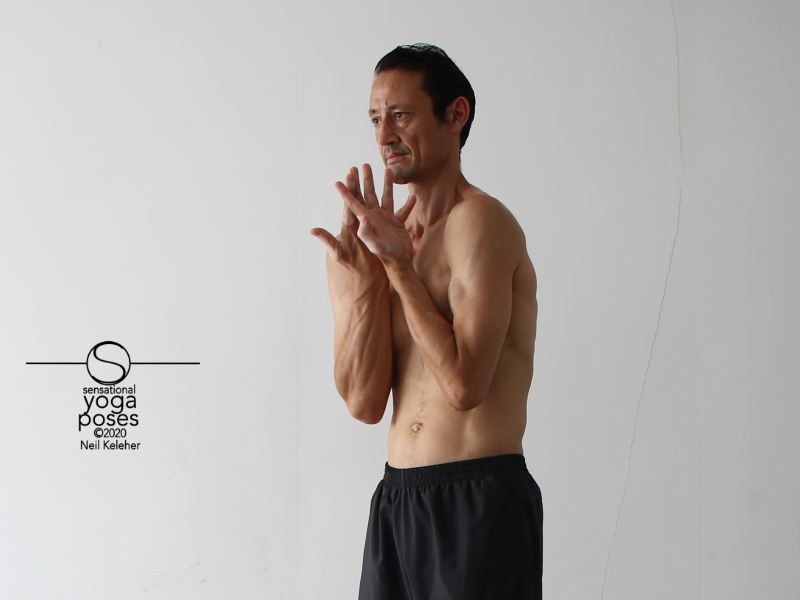
Internally Rotated with shoulder blades protracted
Repeating the same process for internal rotation, first rotate your forearms internally. Then rotate your upper arms. Relax and repeat. Then add shoulder blade protraction.
For these pictures I've actually mixed internal and external rotation.
In the first position, my upper arms are externally rotated but with forearms internally rotated. In the second position my upper arms are internally rotated but with forearms externally rotated.
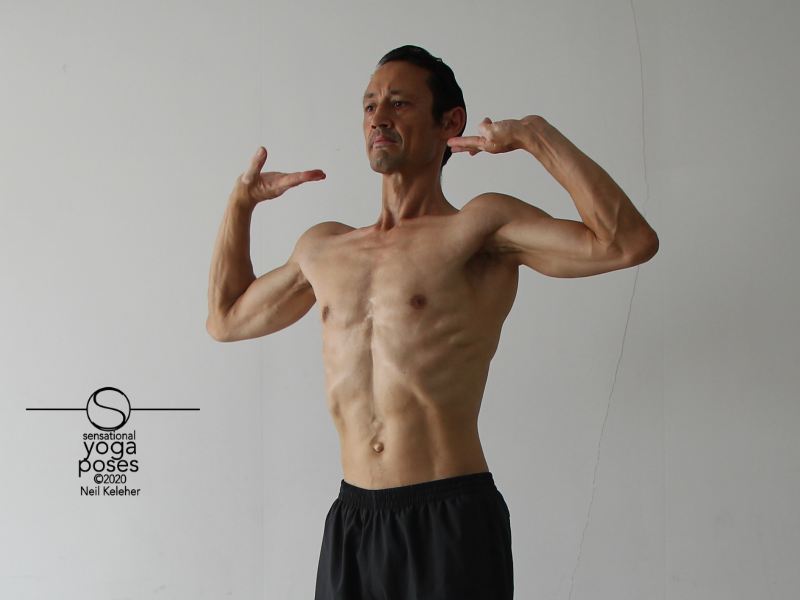
Upper arms Externally Rotated, forearms internally rotated.
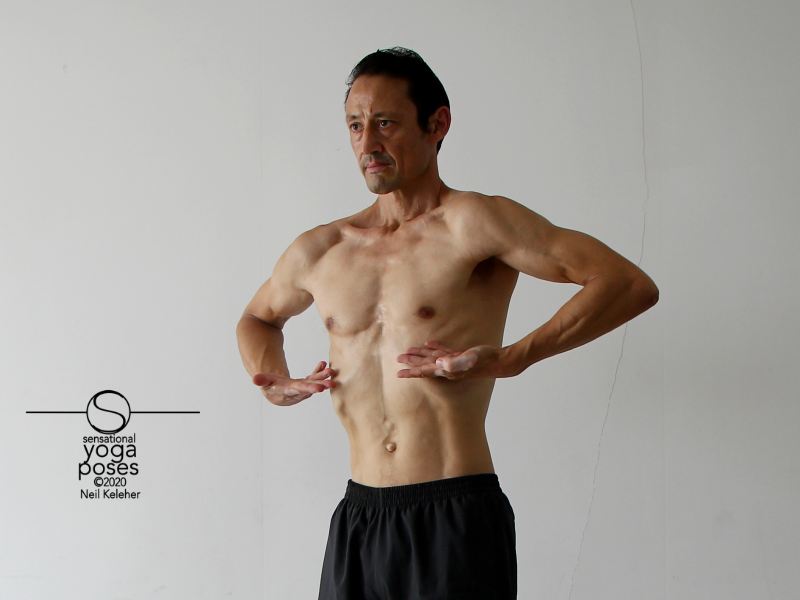
Upper arms Internally Rotated, forearms externally rotated.
So one lesson to take from this is that once you've learned to internally and externally rotate your forearms and upper arms, you can play around with different combinations. As a matter of fact, dance of shiva is a practice based on this very same idea. You learn different elements, then you practice those elements in different combinations. The goal, to be able to do all movements freely.
For these positions too, I mixed up the forearm rotations. (See if you can figure out how to externally rotate forearms and upper arms with elbows bent and pointing forwards. Likewise for internally rotated.)
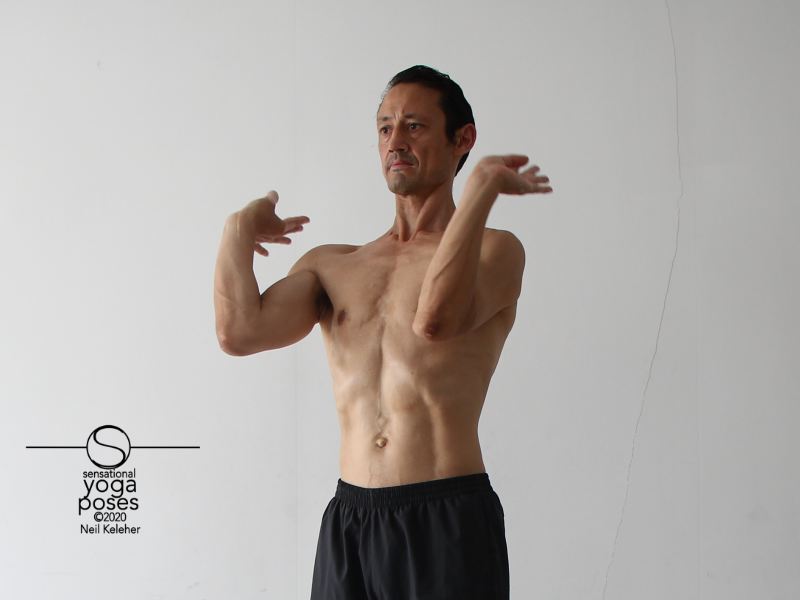
Upper arms Externally rotated, forearms internally rotated.
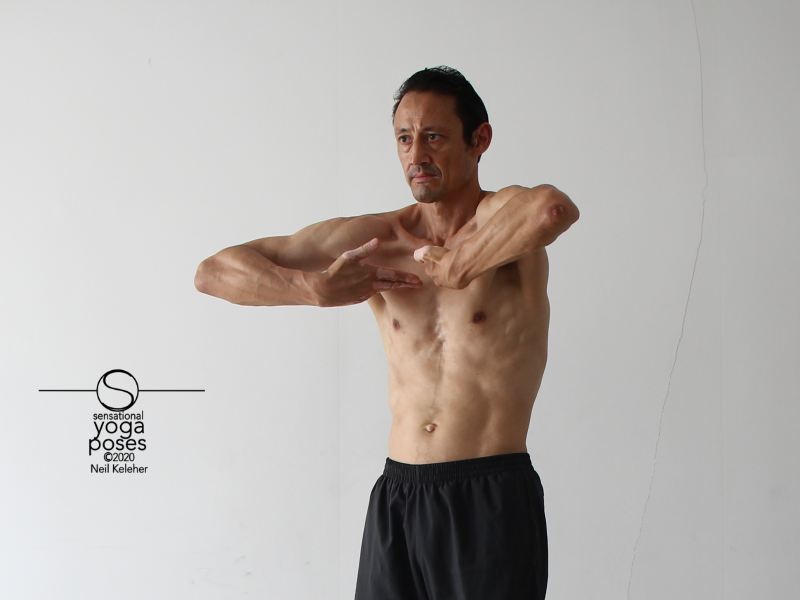
Upper arms Internally rotated, forearms externally rotated
To figure out the forearm rotation, first rotate the forearms with the arms down. Then bend the elbows keeping the forearm rotation. Then point the elbows forwards and internally or externally rotate the upper arms as required.
These next positions are fairly simple to execute if nothing else because the elbows are only bent to around 90 degrees.
Note that for external rotation the upper arms are down by my sides. For internal rotation the upper arms are out to the sides.
For external rotation, rotate the upper arms outwards, then rotate the forearms.
For internal rotation, again rotate the upper arms first. (Note the direction my elbows are pointing for the external and internal upper arm rotation.) Then rotate the forearms.
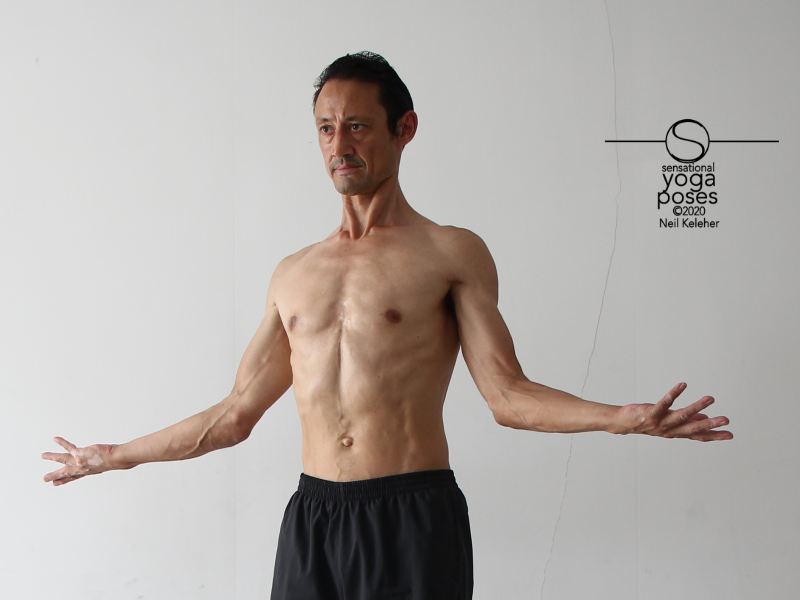
Externally rotated

Internally rotated
Here's the view from the back so that you can see how the shoulder blades retract when the upper arms are externally rotated and protract when the upper arms are internally rotated.
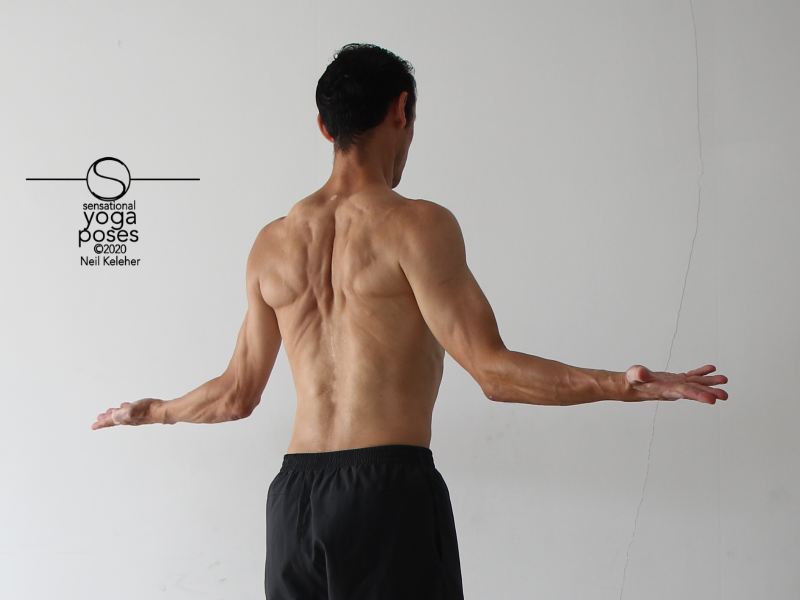
Externally rotated
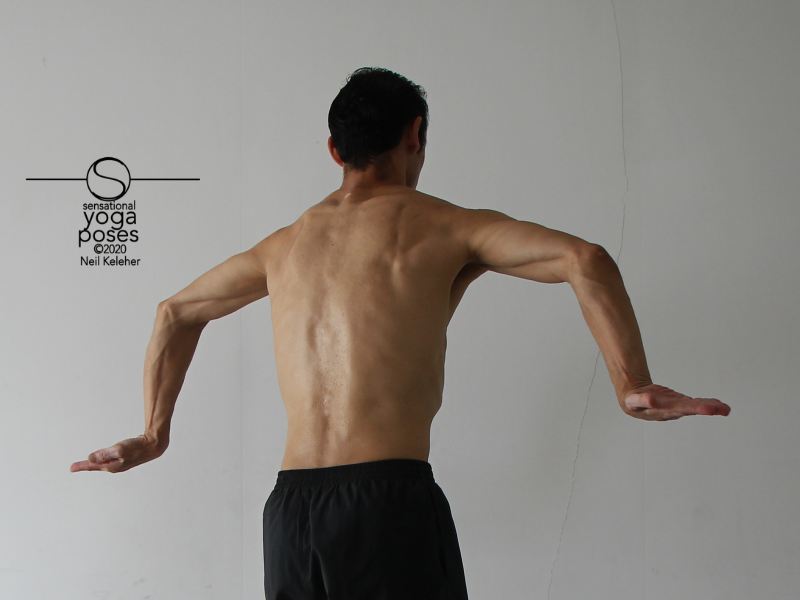
Internally rotated
If you do nothing else, this last set (above) is probably enough for a regular practice of upper arm and forearm rotation.
Note that you could also include chest movements, lifting the chest for external rotation and descending your chest prior to internal rotation.
Work at keeping your spine long in either case.
For more shoulder exercises check out the dance of shiva.
Published: 2012 02 05
Updated: 2021 03 07
